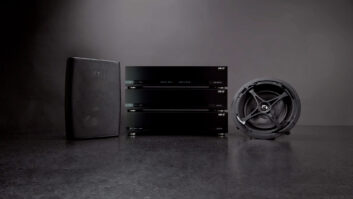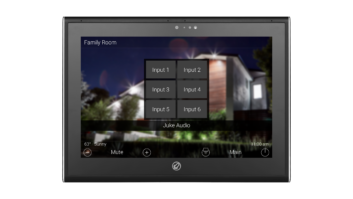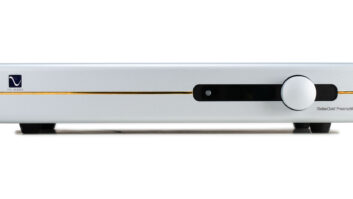In the custom installation business, modesty can be among the rarest of commodities. Ask most dealers, “Who’s the best designer/installer you’ve ever seen?” and you’re more likely to receive a boasting, Right Stuff-inspired, “You’re looking at him!” as you are to gain a truly critical assessment of the industry.
But, at least one company stands above all of this chest thumping and self-aggrandizement. Led by the uncompromising focus and competitive spirit of Mark Ormiston, Seattle’s Definitive Audio finds itself to be consistently ranked, officially or unofficially in the top five of most dealer lists. However, ask Definitive’s president why he’s so well respected, and you would have a hard time getting an answer. In fact, Ormiston thinks what his company has accomplished is fairly unremarkable.
“Our company’s kind of boring, in a way, because we focus on very basic things,” he offered in a rare interview this summer. “A lot of people, particularly in the CEDIA channel like to display their intellect and want to show the unique things about their company or ideas and vision, but I think Definitive, in a lot of ways, is just focused on placing one foot in front of the other. We’re a little company that tries to master very basic things.” Ormiston says that it’s a combination of all the “basic things” Definitive does habitually, that adds up to a “good small business.” While some of his staff secretly wish the company made a more concerted effort to publicize its successes, all seem to have developed a deep respect for their president’s modesty and strong leadership abilities.
“The company overall has a caring attitude toward its employees and that comes directly from Mark,” explained Definitive’s general manager Sean Richter. “He has been my mentor in the way he handles situations, and the way he makes decisions.”
Richter says that almost everyone in the company also has inherited their boss’ self-critical attitude toward business success. “It’s constant self-evaluation, introspection and analysis of how we’re doing things and how we can do them better,” Richter said. “Our benchmark is not what other A/V dealers have done, but instead, it’s based on the approach of the professional construction design community and how coordination happens on those types of projects.” Although Ormiston has taught his team to be humble about their successes, he hasn’t failed to instill an infectious sense of pride in the work they do. “Everybody who works here recognizes that this is an elite company. Everybody just wants to do a good job,” Richter added. “Whenever I hire a new installer, there’s always this odd-man out period until that person can prove to the guys that he is hard working, does a good job, keeps things clean and keeps himself busy. They all have this expectation that is typically a management-level expectation of employees. If they’re not cutting the mustard, the guys will really start complaining about it.”
Definitive’s vice president of sales and marketing, Craig Abplanalp says that, from his perspective, Ormiston’s company structure and clearly defined goals make it easier for everyone to know when Definitive is succeeding and when it is failing.
“When you’re failing you can clearly identify why, and there’s usually a remedy available to you to fix it,” he said. “We’re far from perfect, but Mark has the wherewithal to keep us from drifting too far off course.”
The course that carried Ormiston to A/V retail sales and custom installation is both unique and common to many others in the business. A self-described “hardcore” audio enthusiast since grade school, he put himself through business school at the University of Washington, paying for his education by working in a grocery store on the weekends and a stereo store during the week. As he prepared to graduate with a degree in business administration, Ormiston assumed he would simply go to work in the finance department at “some large company.” However, it was Ormiston’s interest in music and audio equipment that won out, when the owners of Definitive Audio came calling.
“At the time, I was working for a smaller competitor of Definitive,” Ormiston explained. “They approached me, coincidentally, at the time when I was graduating. As it turned out, one of the three founding partners was interested in selling his portion of the company. When they approached me, one of the incentives was the opportunity to buy that person’s interest in the business, which they financed with an employee stock option plan. That’s how I ended up in the stereo business.”
When it opened in 1975 Definitive was a purely a high-end audiophile company, located among 20 other stereo stores in Seattle’s University District. When Ormiston joined in 1983 the company still consisted of only four people, who continued to focus largely on the same business they started out doing. Ormiston says that while the company had “made some progress” in its eight years, it had reached the stage where it had “started treading water.”
Over the years, Definitive evolved beyond straight high-end retail roots, bringing on an increasing amount of custom installation work. By 1990, Ormiston had been named president of the company and had bought a couple of vans and hired a few installers.
“It was at that time that we realized we would really need to revamp how we were looking at the business,” Ormiston recalled. “My business partners and I wanted everything we do to be meticulous, and we felt felt that organizationally we had some problems that were causing us to fall short of the aesthetic and performance result that we wanted.” By comparison, Definitive was as good as any other company at the time, but Ormiston remembers thinking that no one in the company felt that was good enough.
“Everybody, privately, thought we weren’t as good as our billing was,” he explained. “We felt the need to have a completely engineered solution and wanted to bring professional business management and organization to our custom division.”
As a result, Ormiston and his team established a new plan for custom installation in 1990. “It’s laughable now to look back on what we did in 1990,” Ormiston said. “We basically assigned Roland Torngren, to be our only full-time engineer. The term ‘engineering’ was used very loosely at that time. Basically, Roland started looking at our designs from a technical standpoint, then would document and draft and engineer them.”
Next, Definitive assigned a project coordinator, who would schedule and collect accounts receivable and manage assignments in the installation department. “We had a few installers, and we felt like for the first time we had a department,” Ormiston remembered. By 1996, the company had grown to the point where it was stumbling over itself once again. Definitive had been operating a second showroom, in Bellevue, Washington, for the past three years, and the company was just starting to experience the recovery of the recession of 1991-93. Nonetheless, Ormiston was frustrated because he wasn’t making enough money in custom installation.
“The stress of our disorganization came on our installers and our customers,” he explained. “We were basically making up for flaws in preparation and planning and communication/organization that a truly professional business would largely manage ahead of time. We were managing those things at the point of installation. It was unacceptable to me. I really had to make a decision to become more profitable, or I needed to get out of the custom part of the business.”
Just as others now often turn to Ormiston and Definitive Audio for business management advice, in 1996 the Seattle-based company utilized the wisdom of other successful companies in the industry to get them through their transition.
“The biggest thing I get out of PARA, and what I also get out of CEDIA today, is that I meet people more successful and more seasoned at business than myself. They are willing to share with me a lot of their experience,” Ormiston explained. “In 1996, I was especially motivated as a student. I was fearful. I was worried about our solvency, financially, and I was worried about our morale.” Not that Definitive’s business was in terrible shape, but Ormiston and his team had what he calls “a healthy fear of failure” and a feeling that they “could do better.”
Through his connections within PARA, Ormiston made two specific connections, who offered their business insight and an opportunity to study their successful operations. One was with Mike Hagg, who now is now president of Showcase Home Entertainment in Arizona, but at the time was running a consulting service for a few dealers. The other was Walt Stinson, who was the founder PARA and president of Listen Up, Denver, Colorado.
“These were both guys that to me were icon status,” Ormiston said. “They didn’t feel accessible to me; I felt somewhat intimidated by them, but I was motivated to see if they could help.” Hagg was called upon to help develop leadership consensus at Definitive’s board of directors and ownership level. Ormiston also hired a consulting company called Outcalt and Johnson that help them “become better owners and directors” of their business. At the same time, Ormiston turned to Stinson for help in the custom installation area of the business.
“Listen Up was a company that had a good reputation because they had financial management, a professional organization, and they did not only custom installation, but were doing commercial installations and were a retailer, as well. To me, they were the first retail/custom installation hybrid,” Ormiston said. “Walt was known as a manager’s manager–a real organization guy. I asked if I could spend a day there on the way to a PARA Conference, and I went down there to absorb as much as I could. What I saw blew me away in terms of where we were with our company.”
Ormiston was impressed that Listen Up had a dedicated facility for custom installation, as well as an “org. chart,” job descriptions and process manuals. “They were making money and had a dedicated manager running the division. Whereas we only had people managing the schedule and accounts receivable,” Ormiston said.
Although he didn’t think he would have the financial resources make all the necessary changes to match Listen Up, Ormiston says he returned from his trip with the resolve to do it, somehow. “I borrowed some money. I leased the space adjacent to us. I came back with their org. chart and I filled it out with a lot of blank spaces,” Ormiston recalled. “I knew it was going to start with who I hired to run the division.”
That’s when Ormiston found Sean Richter, while not possessing any previous management experience, had developed a strong understanding of project management while working at one of the top architecture firm in the Seattle area.
“He’s become one of the strongest aspects of our business,” Ormiston said. “He helped develop the org. chart and the process we have now. We’ve developed a scaleable model that has allowed us to both grow and contract with business.”
If Ormiston is willing to boast about one thing, it’s his nose for finding talented people for his 60-plus person staff. He points out that while many of his employees have been hired without prior experience in the area they were hired to cover, he can usually tell that they are perfect for the job. For instance, his project manager was an event coordinator who previously organized promotional events for major sports teams. Then there’s his draftsman who previously drafted cockpit interiors, making sure he drew wiring diagrams that would meet FAA standards.
Now, with the help of Richter and Craig Abplanalp, Ormiston runs a tight ship where everything is “buttoned down.” From the way they do their job costing, to their project scheduling, to their communications and training, Ormiston and his team run a tight ship, that’s still loose enough to allow for creative interpretation. “We have a lot of innovation and creativity, and I don’t think we’re robot-like,” Ormiston said. “I think our processes allow for a lot of interpretation and flexibility but we have certain things in terms of technical completeness and physical neatness and customer services that people know within those boundaries they do things a lot of different ways and still have personal expression.”
Sometimes, however, Ormiston’s staff finds it hard to live up to his exacting standards. “At times it can be really tough working with him, because he’s not really willing to overlook anything,” Abplanalp said. “For instance, if you’re trying to grow your sales and maintain the standard it’s pretty hard to do both. We were growing at 35 to 40 percent per year, from 1995 to 2000. To increase the revenue at that rate and then to hire the people who can support the standard is really tough. You’re talking about bringing a lot of new people into the organization and either insisting that they understand what we do or making them understand what we do.”
Despite his tough leadership style, to his credit Ormiston is not a hands-in style manager. “He’s not looking for our company to be, ‘Mark Ormiston’s Definitive Audio,’” Abplanalp pointed out. “He realizes that there are a lot of people here who work hard, and he is just the guy who’s keeping the boat on course, not doing all the work himself.”
Ormiston says that what he’s done with Definitive Audio isn’t complicated, but yet is quite calculated. “We’ve never varied from our values or our interests,” he explained. “We’ve adapted our company a lot, but we’ve always done it within the context of a set idea of how we conduct ourselves, what we’re interested in and how we want to do things.”
Sam Runco, founder and president of Runco International, notes that Ormiston, his top dealer in 1999, manages his company as a business–something many companies in the predominantly “hobbyist” world of A/V have yet to learn. “The combination of Mark’s business acumen and objectivity and his marketing savvy and honesty were big factors in the way he put his business together,” Runco said. “He does it in a more calculated way than most other dealers.” Respect from vendors, such Runco, B&W, Transparent Audio, Madrigal, Meridian, Snell & Wilcox and Faroudja, has been earned, in part, from Definitive’s loyalty and smart sales approach. “We deliberately try to go narrow and deep with most of our vendors,” Abplanalp said. “On any one category of product we don’t try to have a lot of selection. We try to make sure we’re presenting an option that makes the most sense to us as business owners and to our customers and to our vendors. As a result, we’re always in the top five on our lines.” Richter points out another way Definitive, under the guidance of Mark Ormiston, stands out from the rest of the industry. “We love to take clients and walk them through our design center and show them a guy on the computer cranking on AutoCAD or programming AMX,” he explained. “We point out our project managers and all the infrastructure behind them. We have an electrical engineer on staff. We’ve got an architect on staff, we’ve got two technical designers that are well versed in AutoCad and Phast programming. I think it really gives the clients a sense of how we’re different from the competition.”
Ormiston says that rather than judging his company solely on its strong technical credentials, however, he rather point to Definitive’s longevity as a business and its ability to gradually and continuous improve over time.
“It’s the happiness of our clients and employees, as well as the profitability and stability of our company that’s most important to me,” he said. “We’re honest and respectful to our trade and love what we do, but we really try not to take ourselves too seriously. This is a small business, in a small industry and, in the end, we want to make money while also making a lot of people happy.”
–Jeremy Glowacki is editor of Residential Systems.







